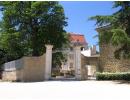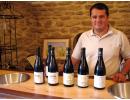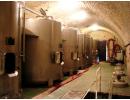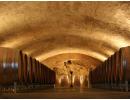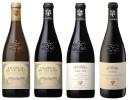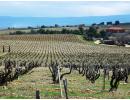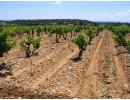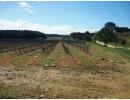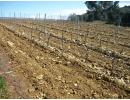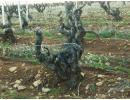Chateau de Vaudieu
Châteauneuf du Pape - Rhône Valley
Jed Dunnuck: Located just across the hill from Rayas..... These are powerful, rich wines that never lose their sense of balance and purity.
Château de Vaudieu - Châteauneuf du Pape
A blend of 85% Grenache Blanc with 10% Roussanne and 5% of other varieties such as Clairette and the rare Picardan, the precentages will vary depending on the vintage. The vines averageing 30 years of age produce a low yield of 28 hl/ha from a 10 ha parcel. Fermentations are done in stainless steel vats for 10 to 12 days at 18°C - 22°C, the Roussanne is fermented in french oak barrels for 1 week at cellar temperature. The wine is aged on fine lees for 8 to 10 months in concrete vats, except for the the Roussanne which is aged in new oak barrels of 228 litres. Malolactic fermentations are carried out.
PVins notes: The wine is yellow in colour, layers of flavours of white flowers and citrus fruits fill the glass, its rich, concentrated and fresh with a long finish. The wine will reach its peak after 5 years but may be cellared over 10 years.
Château de Vaudieu - Châteauneuf du Pape
As the main wine of the estate representing 60 ha, its blend is Grenache Noir with Syrah and Mourvèdre. The percentage of each grape variety used will depend on the potential of the vintage, knowing that the Grenache is usually the dominant grape. The vines vary from 40 to 70 years of age producing a low yield averaging 25 hl/ha. The grapes are destemmed, fermentations are done in stainless steel vats over 30 days at 28°C and each parcel is fermented separately. Ageing will last 14 to 18 months with the Syrah and Mouvèdre (separately) in new french oak barrels of 228 litres while the Grenache is aged in demi-muids of 600 litres.
PVins notes: The wine shows black fruit flavours and spices with hints of mocha, medium to full-bodied, well-balanced, it needs a couple of years after release for the tannins to smooth out. A great wine to cellar and enjoy over 15 to 20 years.
Château de Vaudieu "Val de Dieu" 2015 / 2012 - Châteauneuf du Pape
This premium wine's blend is 60% Grenache Noir with 25% Syrah and 15% Mourvèdre. The percentage of each grape variety will vary a little depending on the potential of the vintage. The grapes from the 70 year old vines are hand-picked at full maturity giving a very low yield averaging 15 hl/ha. The grapes come from 2 parcels representing 3.25 ha located to the north and east of the Château where the soil structure is sandy. The grapes are destemmed, the fermentations in tulip shaped concrete vats will last a month at 25°C - 28°C, the Mourvèdre is fermented in demi-muid barrels at cellar temperature. Ageing will last 18 months with the Syrah and Mourvèdre (separately) in oak barrels of 228 litres and the Grenache in demi-muids barrels of 600 litres. A small quantity of this premium wine is produced.
PVins notes: Great depth, a complex nose of small redberries, mild spices, mocha and hints of cedar wood. The palate is well-balanced, dense, powerful with perfectly integrated tannins, remarkable precision with a very long finish. It needs a couple of years after release for the tannins to smooth out. A great wine to cellar and enjoy over 15+ years.
2015
Wine Advocate 94
A traditional blend of 60% Grenache, 30% Syrah and 10% Mourvèdre and aged predominantly in demi-muids, the 2015 Chateauneuf du Pape Cuvee Val de Dieu is richly tannic yet plush, marked by its stay in oak. Vanilla and baking spices abound, yet they blend readily with the mixed-berry fruit and velvety texture. It's approachable now if you're partial to vanilla, berries and cream, but I expect it to develop some more savory characters within a few years. Drink 2020 - 2035.
Jeb Dunnuck 94
The 2015 Châteauneuf-du-Pape Val de Dieu (60% Grenache, 30% Syrah, and 10% Mourvèdre) offers a similar style, with notes of caramelized raspberries, spice-box, dried garrigue and hints of vanilla. Elegant, full-bodied and utterly seamless on the palate, it has ripe, sweet tannin and a great finish. Like the tradition, it's a more elegant, silky style of wine that's already a joy to drink.
Wine Spectator 95
This has the fleshy, pure and driven vintage profile of cassis and raspberry running right down the middle, with an amped-up finish of roasted apple wood, graphite and ganache notes providing a thumping bass line. Needs a little more time to knit fully, but that won't be a problem. Best from 2020 through 2040.
2012
Wine Spectator 94
Featuring a gorgeous mouthfeel from the start, this caresses with silky layers of crushed fig, blackberry and black cherry fruit while notes of black tea, Black Forest cake and ganache fill in the background. The graphite-fueled finish is sneakily long. A beauty. Best from 2016 through 2027.
Wine Advocate 95
A knockout bottle of wine, completely destemmed, and aged 18 months in new demi-muid, of which every trace is soaked up. Showing fabulous sweetness and purity on the nose, with black raspberry, black cherry liqueur, crushed flowers, white pepper and hints of licorice, it hits the palate with medium to full-bodied richness, solid mid-palate depth and ultra-fine tannin. I think it will age beautifully, but given its polish and seamlessness, it’s a superb drink even now. Drink 2015 - 2027
Vinous.com 93
Inky ruby. Ripe cherry and black raspberry on the highly perfumed nose, with a suave floral element adding complexity. Fleshy and seamless on the palate, offering pliant red and dark berry flavors and hints of vanilla and smoky minerals. Closes smooth, sappy and very long, with excellent clarity and spicy lift. This very well-balanced wine possesses the balance to age but also abundant upfront fruit to make it quite appealing now. Drink 2018 - 2025
Château de Vaudieu "Amiral G" 2015 - Châteauneuf du Pape
A 100% Grenache Noir premium wine. The cuvée is in homage to Amiral Gérin who built the estate's château in 1767. The "G" in the name is also to pay tribute to Châteauneuf's king of grapes the Grenache. The wine's grapes come from some of the best parcels, covered by pebbles with a red clay sub-soil structure situated on the villafranchien plateau of Châteauneuf. The grapes from the 20 years old vines are hand-picked at full maturity, giving a low yield averaging 25 hl/ha. The grapes are destemmed, the fermentations in tulip shaped concrete vats will take a month at 25°C. The ageing will last 18 months in new demi-muids oak barrels of 600 litres.
Wine Advocate 95
The entire range of wines from Vaudieu is impressive this year, but we start with the seductive 2015 Chateauneuf du Pape Amiral G, a pure-Grenache cuvée aged in demi-muids. Cherries, stone fruit and a touch of garrigue on the nose, supple tannins on the palate and a long, spicy-silky finish tinged with vanilla make this a true crowd-pleaser. Despite it's early appeal, it's a classic beauty with the bone structure to age well. Less than 300 cases were produced, so don't wait on this one! Drink 2020 - 2035.
Jeb Dunnuck 96
My favorite in the lineup is the 2015 Châteauneuf-du-Pape Amiral G., and like all the cuvées here, it has a voluptuous, sexy, yet elegant style. Black raspberries, framboise, spice-box, and floral notes all give way to a full-bodied, powerful, yet incredibly elegant Châteauneuf that has a weightless texture and a blockbuster finish. It's already drinking nicely, yet should cruise for a decade.
Wine Spectator 96
Features a solid core of lightly steeped kirsch, black cherry and raspberry fruit, backed by singed juniper and apple wood notes that lend aromatic and textural contrast. Tobacco, shiso leaf and blood orange details score the finish, giving this a mouthwatering profile. Best from 2020 through 2040.
Other wines from the Family Brechet also imported are Domaine des Bosquets in Gigondas and Plateau des Chênes from Lirac.
Château de Vaudieu is located in the heart of the appellation Chateauneuf du Pape at the lieu-dit "Vaudieu" near "Rayas". It was built in 1767 by Admiral Gerin a lieutenant of the admiralty of Marseille. For over 250 years, this area known as “Val de Dieu" (Valley of God) later becoming “Vaudieu”, has sheltered vineyards in a landscape of hills and terraces with the best possible exposure. In the mid 19th century, just before the phylloxera crisis, the estate was one of the four great vineyards of Châteauneuf-du-Pape capable of producing more than 200 hectolitres of quality wine.
In 1955, Château de Vaudieu with its 24 ha was purchased by Gabriel and Juliette MEFFRE, the estate was rundown and a lot of work was needed to rehabilitate it. Gabriel and Juliette are the grandparents of today's owners Laurent and Julien Bréchet. Both Gabriel and Juliette are from winegrowers background. The Meffre family has its roots in Gigondas where they have been cultivating vines throughout the southern Rhone Valley for over 5 generations. While Juliette's father Auguste Chauvet, Laurent’s maternal great grandfather, was already a Gold Medalist in the 1900 wine show in Paris having 10 ha of vines and some olive trees. When Juliette took over her father's estate with her husband Gabriel Meffre they decided to remove some olive trees to plant more vines instead. This explains the coat of arms embossed on the wine bottles from the various Family Bréchet estates, it represents an olive tree with a vine leaf and grapes. The family’s coat of arms has been officially accepted by the Châteauneuf du Pape appellation in replacement of the appellation's classic emblem on the bottles. It was under the leadership of Gabriel and Juliette Meffre that the vineyard of Château de Vaudieu reached its current size of 70 ha as a single vineyard within a 450 metres radius of a bicentennial Lebanese Cedar tree planted in the 18th century.
Upon the death of Gabriel Meffre in 1987, his daughter Sylvette Bréchet took over the destiny of this magnificent property. Her son Laurent became involved in the running of Vaudieu in 1990, while her other son Julien manages Domaine des Bosquets in Gigondas since 2006,an estate she inherited in 1963. Through her sons involvement, the cellar of Château de Vaudieu is modernised in 2001-2002, to accommodate the 32 parcels redefined in order to achieve the best potential from each terroir. Laurent Brechet is surrounded by a team focused on quality with the advice of consultant Philippe Cambie since 2003. Laurent continues the meticulous work at Vaudieu respecting the terroir and its environment and thus giving rise to 3 prestigious cuvées "Val de Dieu", "Admiral G" and since 2007 "Clos du Belvédère".
The latest acquisition by the family Bréchet was in 2010, a property of 25 ha in the nearby appellation Lirac. The wine is named “Plateau des Chênes” and the estate is managed by Laurent and his team. This latest acquisition joins the list of estates owned by the family Bréchet which are: Domaine de la Jérôme a Côtes du Rhône Villages in Séguret, Château la Coulerette in the Côtes de Provence and Domaine des Bosquets in Gigondas.
Chateau de Vaudieu's 70 ha are situated in the heart of the appellation made up of 32 parcels set around the Château. The vines are aged between 40 to 70 years old. The vineyard is planted as follow: 60 ha in red grapes and 10 ha in white grapes. The Grenache Noir is predominant on the estate representing 40 ha. The other red grape varieties planted are: Syrah, Mourvèdre, Cinsault, Counoise, Terret Noir, Vaccarèse and Muscardin. For the white grape varieties, the main grape planted is Grenache Blanc complemented with Roussanne, Clairette, Bourboulenc, Picpoul and some Picardan one of the oldest and rarest varieties of the appellation.
The vineyard covers a mosaic of terroirs with more than 7 distinct geological soils. Here side by side, you find sandy types of terrains, terraces of large pebbles, marls and slopes with limestone soil all ranging at an altitude of 85 to 125 metres. All these terroirs and parcels are vinified and aged separately until the final blending. The very fine tannic structure of the red wines come from the high proportion of sandy terroir, while the minerality of the limestone with flint bedrock is what shapes the white wines. The acidity is an important element for balance and ageing, this is revealed through the premium white wine "Clos du Belvédère" made with 100% Grenache Blanc, the wine is named after the parcel of the same name.
The vineyard is sustainably farmed with some organic approach. Canopy management and green harvest is practiced when necessary, the harvest is hand-picked.
The grapes are hand-harvested early in the morning to keep the night’s freshness on the grapes and also to avoid working in the heat. Harvesting will last about a month as the different grapes and parcels reach full maturity at different times. This approach has been facilitated following the modification of the cellar. Château de Vaudieu is now able to vinify each grape variety and parcel separately. The first sorting will be done in the vineyard at time of picking, only the best bunches will pass the cellar’s door were a second "tri" will be done. The yields are very low on average 25 hl/ha.
Laurent users the services of Philippe Cambie as a consultant since 2003, a very well-known oenologist in the region. He has had a very positive influence on the style of Vaudieu even though Laurent and his winemaker have the final say. The winemaking process is classic, the grapes are de-stemmed and the fermentations are carried out with indigenous yeasts in stainless steel vats. Extractions are long and soft in order to obtain very fine textured wines, but never at the expense of concentration. In order to push the parcel approach to its limits, new 86 hectolitres “tulip” shaped concrete vats were introduced in 2013, they are used for some specific parcels. These new vats are the same that were designed by the famous Bordeaux 1st Growth Château Cheval Blanc in Saint Emilion. These new shaped vats are made to facilitate the maceration between the must (without stems) and the juice in a smoother way and to better control the temperature of the vat. After the fermentations the juice is transfered by gravity from the vats into concrete vats buried below the cellar, thus suppressing the use of pumps in the transfer process. The red grapes are aged separately for 15 to 18 months in concrete vats and oak barrels of various sizes depending on the grape and the wine produced. The wines are cellared after bottling for one to 2 years before release.
As for the white wines, the grapes Grenache Blanc, Roussanne, Clairette and Picardan will be slowly pressed as whole bunches. The fermentations will be carried out in stainless steel vats or oak barrels depending on the wine and the grape. Again depending on the wine and grape, the ageing will be done in oak barrels or concrete vats for 6 to 9 months, some new oak barrels are also used.
Laurent Bréchet produces 5 Châteauneuf du Pape which include 2 whites and 3 reds of which 3 are premium cuvées. The premium white is named “Clos Belvédère”, named after the parcel of the same name which is the best of the estate for white grapes. The wine is made from 100% Grenache Blanc and only about 3,000 bottles are produced when the vintage allows it. The premium reds are: “Val de Dieu” which includes 70 years old Grenache vines in the blend from the best 2 parcels and “Admiral G” which is only produced in excellent vintages made from Grenache Noir only.
French version (english subtitles)
Links: AOP Chateauneuf du Pape - Southern Rhone map
CHÂTEAUNEUF DU PAPE
The appellation Châteauneuf du Pape located 15 kilometres north of Avignon is the most famous appellation of the southern Rhône region. It was consecrated an A.O.C. in 1933, the first of its kind in France. The 3,210 hectares of vineyards spread over five communes: Châteauneuf du Pape, Bédarrides, Courthézon, Orange and Sorgues.
History
Like all appellations in the Rhône valley Châteuneuf du Pape has a long history of viticulture dating back to the Romans. However, the first written evidence of its existence dates from 1157. But the Popes in the 14th century were the real developers of the vineyard. In 1314, Pope Clement V the first Avignon Pope discovered the special soil of Châteauneuf-du-Pape. In 1316 he was succeeded by Pope John XII who regularly drank the wines from the vineyards ‘in the north’ and did much to improve viticulture practices. He also found the ideal spot on a hillock overlooking the Rhône Valley about halfway between Avignon and Orange to build a castle “Châteauneuf” which began in 1317 and was completed in 1333. Under the reign of Pope John XXII, the village became the summer residence of the Papacy and he promoted the wine to the rank of "Vin du Pape", during his reign the vineyard grew in size and reputation. Throughout the 16th and 17th century the area suffered from many plague epidemics and wine production slowed down. The plague was probably responsible for the sudden drop in population in Châteauneuf from 1,200 to 558 people. At the beginning of the French Revolution the name changed to “Châteauneuf d’Avignon” as the properties of the church were dismembered by the Republic.
Despite the unfortunate consequences of a non-regulated market in the 19th century, the wines of Châteauneuf-du-Pape were very well-known. In the early 19th century some estates started bottling their own wines and later exported them. Anxious to defend the growing reputation of the wines from Châteauneuf-du-Pape, the winemakers were at the origin of the current system of AOC. With no legislation to protect the appellation, fraud was a real problem: grapes and wines from outside the region entered the commune in order to benefit from its prestigious name. In 1894, the winegrowers established a Syndicat Viticole presided by Mayor J. Ducos to put a stop to this fraud and guarantee the quality of Châteauneuf-du-Pape. The 1919 wine appellation law did not put a stop to fraud, as it was too general and essentially limited to the question of geographical boundaries. Judging the 1919 Act on designations of origin too general they decide it was time to put in place stricter regulations and more specific legislation to protect their appellation. They were well aware that the best way of promoting and protecting their wines was to improve its quality. In 1923 a delegation of vignerons went to Château Fortia owned by Baron Le Roy Boiseaumarié a winemaker and a lawyer by trade to seek his help in this task. The Syndicat took legal action at the Orange law court in order to define all the conditions necessary to entitle the wines to the name of Châteauneuf-du-Pape. Thanks to Baron Le Roy’s enthusiasm and his legal expertise, the Cour de Cassation (French court of last resort) defined the appellation boundaries and production conditions on the 21st November 1933 after several years of proceedings. Châteauneuf-du-Pape winegrowers were therefore the first in all of France to impose production regulations. Their example, was soon followed by many other French vignerons, paving the way for the creation of a nationwide set of appellation regulations in 1936 known as “Appellation d’Origine Controlée” (AOC), today know as “Appellation d’Origine Protégée” (AOP). In 1937, the union of growers of the appellation chaired by Baron Pierre Le Roy Boiseaumarié, created the famous bottle with the embossed logo. This logo symbolizes a papal tiara placed above the keys of St. Peter with the inscription: "Châteauneuf-du-Pape contrôlé" written in Gothic letters around this emblem. Its purpose was to promote the wines of the appellation and guarantee the authenticity of the wine against counterfeiting. In a judgment delivered in 2004, the French Supreme Court has confirmed the validity of the rights attached to this special embossed bottle of Chateauneuf du Pape for indisputable legal protection.
Vineyard
The town of Châteauneuf is on a hillside with the surrounding vineyards set on a rolling landscape and a large plateau that starts west of the lieu-dit “Mont-Redon” (altitude 119m), going eastward to its highest point in Pied Long (altitude 128m) and finishing southward in the lieu-dit “La Crau” (altitude 110m). The terroir of Châteauneuf du pape was mainly structured during the geological Tertiary and early Quaternary periods. To generalize, one can say there is limestone soil in the western part of Châteauneuf-du-Pape; sand and clay soil covered with large stones on the plateaus; mixed sand, red and grey clay and limestone in the northern part of the appellation; less stony soil alternating with marl in the east and shallow sand and clay soil on a well-drained layer of gravel in the south. The large pebbles carried down the Alps by the Rhône River over time contribute to the quality of the vines and grapes by storing heat during the day and releasing it at night.
There are 13 red and white grape varieties permitted in the appellation: Grenache Noir/Blanc, Syrah, Mourvèdre, Cinsault, Clairette, vaccarèse, Bourboulenc, Roussanne, Counoise, Muscardin, Picpoul, Picardan and Terret noir. Grenache Noir, the main grape variety, is perfect for the region's meager dry soils and Mediterranean climate with hot summers (34-38°c) and strong Mistral winds which keep the vines dry and protected from diseases. The Grenache Noir contributes warmth and strength and typically displays a wide spectrum of flavours while the Syrah, Cinsault and Mourvèdre achieve balance, structure and colour in the blend. The aromatic whites which only represent 6% of the appellation are medium to full-bodied and well-balanced with a crisp freshness.
Climate
The region benefits from an exceptional Mediterranean climate. Châteauneuf is the driest area in the Côtes du Rhône with around 2,800 hours of sunshine every year. The heat stored by the rocks during the day and released at night enables the grapes to reach optimal ripeness. Summers, which are seeing an increase in subtropical anticyclones, are warm and dry with the occasional violent stormy period. The winters are mild with frequent precipitations but snow is rare. Another important element is the Mistral which is a strong wind from the north that blow through the valley for nearly half the year. Its advantage is that it keeps the grapes dry and healthy especially after a rainy period, but there is a saying that if it remains for long period of time it can drive a man crazy.



